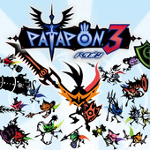Patapon 3 Original Soundtrack
 |
Album Title: Patapon 3 Original Soundtrack |
| Record Label: Sony Computer Entertainment |
|
| Catalog No.: N/A |
|
| Release Date: July 13, 2011 |
|
| Purchase: Download at iTunes |
Overview
The third game in the Patapon series shared the same gameplay as its predecessors, but featured a somewhat richer storyline and other enhancements. For the soundtrack, returnees Kemmei Adachi and Daisuke Miyake offered a range of new tracks, in addition to some remixes of returning themes. The majority of the soundtrack maintains the percussive, chant-based approach of the previous games in the series, though the artists also introduced a contemporary influence to the game. Realizing that fan’s appetites were ripe, Sony Computer Entertainment released a downloadable soundtrack album shortly after the game’s release.
Body
Sony didn’t change the gameplay much with Patapon 3, so anybody who played the first two games should know the drill: instruct an army of Patapons by pressing the right four buttons to the drum beat. “Pata-Pata-Pata Pon” means forward, “Pon-Pon Pata-Pon” means attack, and there is an assortment of other combos that can be during the gameplay. Sony’s decision to adhere to the past gameplay has its fans and detractors, though one thing it limited was musical variety. Starting with the “Ho Hoi Yahha Theme”, Patapon 3 features 22 successive quest themes — all written in quadruple metre, featuring the same andante pace, highlighting the same chanting patterns, and underlaid with similar drum beats. Two games later, it’s difficult to find novelty in this approach and it’s unfortunate that the talented composers behind the score weren’t challenged with new gameplay ideas.
Realizing that the tribal marches could grow old with a third game, the sound team took steps to preserve the creative value of the soundtrack. As with Patapon 2, the tracks erupt into chaos after the “FEVER!” chant with much wilder voice performances. The Donja Lalin and Pala Biyappa stand out particularly for their particularly inspired use of Kemmei Adachi’s chorus performances, the latter having Katamari-esque vibes. What’s more, there’s a more contemporary flavour in the backing tracks than ever before; there’s everything from Tum-ta-ta-tum’s hard rock, to Pata Kolassa’s techno vibes, to Guppy Puppy’s chiptune. A further recipe for success are the rich countermelodies to the chants. An emotional accordion melody provides new substance to the returning Gyorocchi theme, while the instrumental parts in Bon Voyage are even more captivating than the chants themselves.
In a further innovation, Adachi and Miyake offered multiple rock arrangements of popular themes in the franchise. For instance, “Gyorocchi Rock” is an action-packed variation of Patapon‘s classic Goroch theme. It starts off similarly to the original, but incorporates more aggressive chanting and guitar riffs by the climax. The arrangements of Pikkurakotta, Awon, and Ushishi provide special and intense accompaniments to various boss encounters. Aided by Adachi’s experience on the Battle Gear franchises, the electric guitar leads are particularly well-produced in these tracks and sound compelling in combination with all the chants. But in a further example of how Patapon’s soundtracks suffer out of context, these ten tracks are less effective when clustered together on the soundtrack than when heard in dispersed climactic encounters in the game.
The soundtrack is rounded off with a number of additional themes. The first two tracks expose the contemporary vibe of the soundtrack — one an arrangement of the “Patapon Theme” — with their electronic beats and guitar riffs. This influence continues throughout most of the gameplay themes right up to suitably grisly theme for the “Dark Hideout”. In general, such tracks don’t sound as unique or beautiful as most of the cinematic themes on the previously two Patapon soundtracks, though they do inject some variety into the franchise. Nevertheless, there are a number of short but beautiful pieces interspersed during the soundtrack, notably “Campus”, “Turbulent Souls”, and a piano-based epilogue theme. Once again, the ending theme “If This World Has An End…! 3” is a condensed medley of level themes from the soundtrack, this time with a more experimental, rocked-up feel.
Summary
Patapon 3 is easily the biggest soundtrack of the series, though its bulk is as detrimental as it is beneficial to the stand-alone experience. It’s unpleasant to experience 24 successive tracks featuring similar structures, melodies, and chants. However, there is enough variety in the accompaniment and development of such pieces to sustain some interest, especially thanks to the rock and techno influence. Once again, it is best to experience Patapon 3‘s music in the game first, on the album later.
Do you agree with the review and score? Let us know in the comments below!
3.5
Posted on August 1, 2012 by Chris Greening. Last modified on August 1, 2012.














